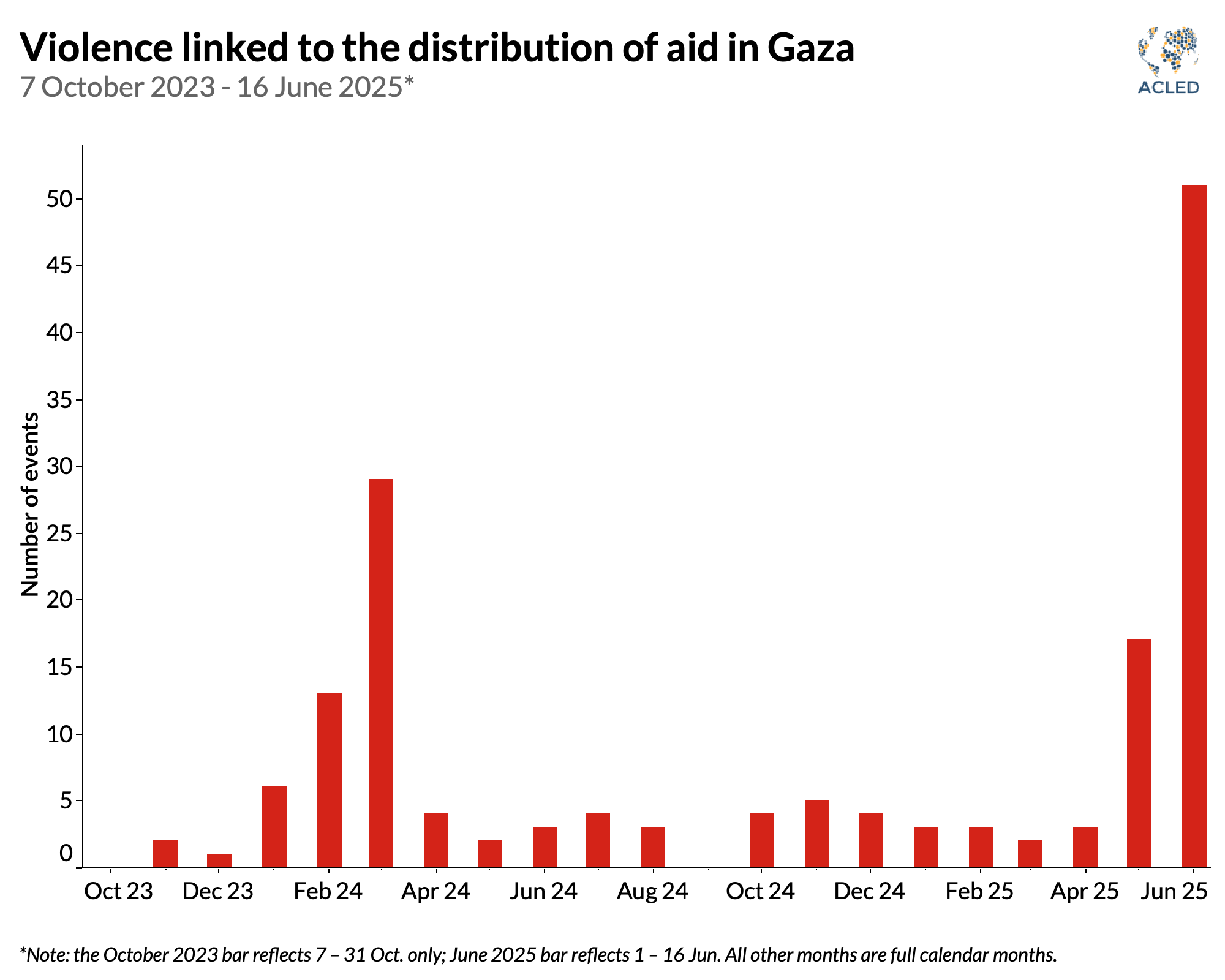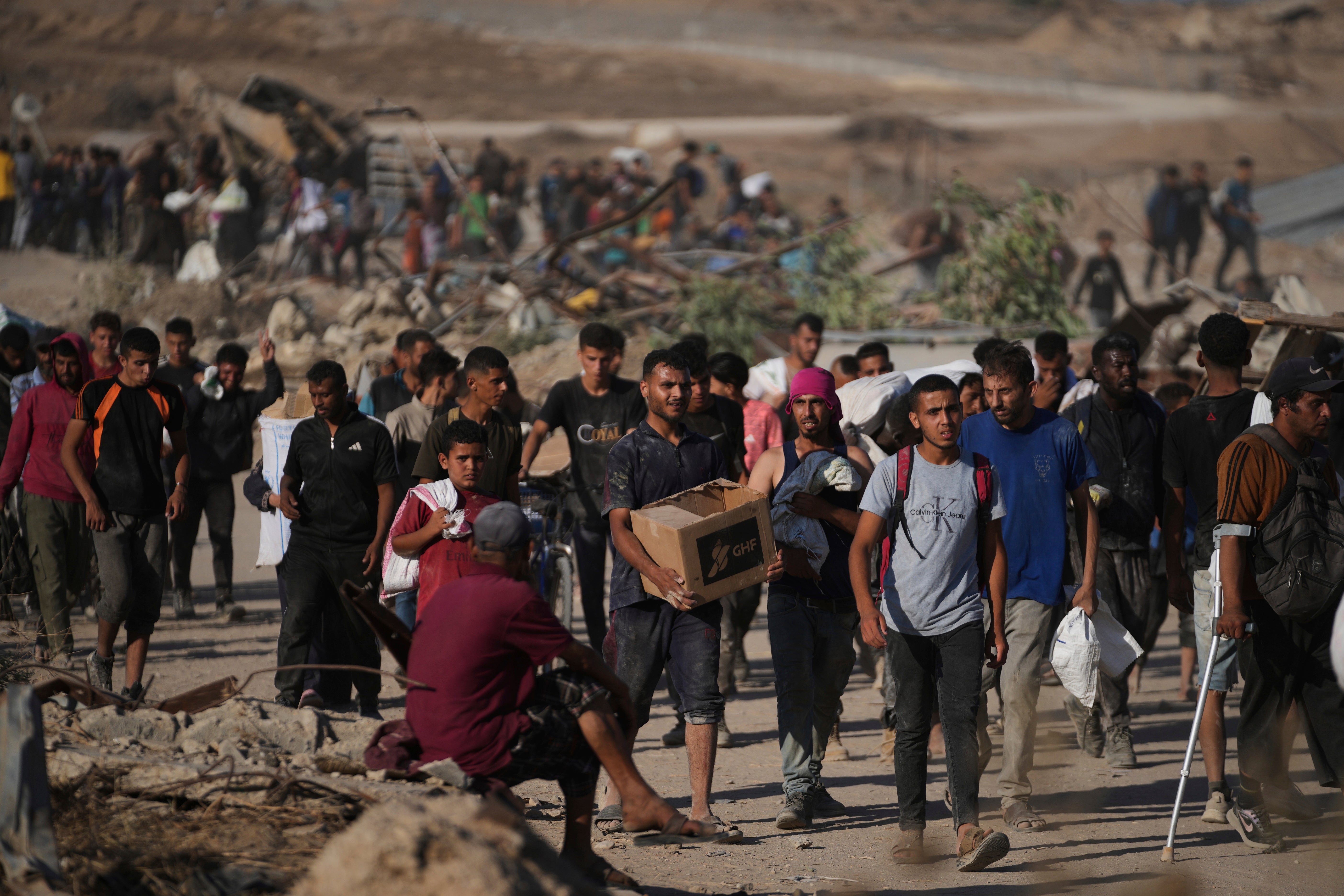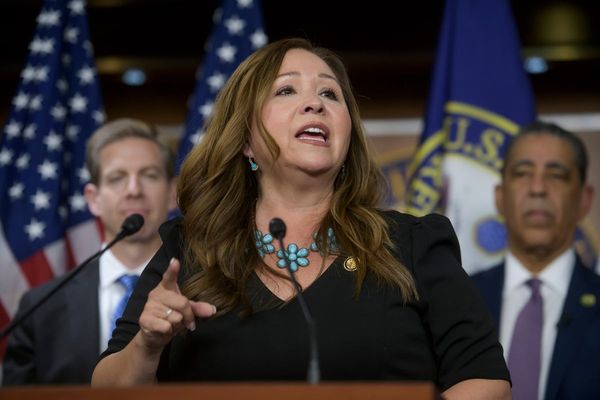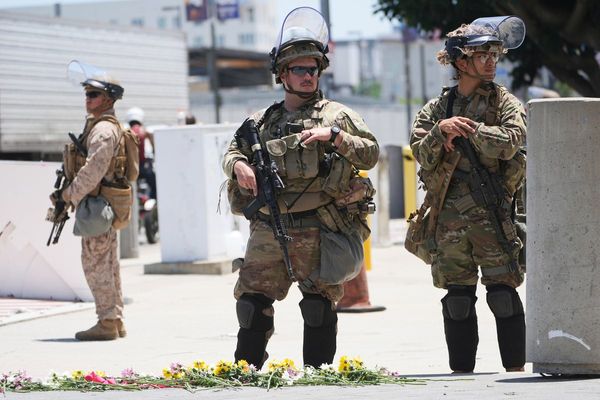Gaza was one of the most densely populated places in the world before the war. Today, the roughly 2 million Palestinians who still call it home have been forced into an area just a fifth of its original size by a year and a half of bombing, displacement orders and militarised zones.
Under a bleak vision for the future pitched by Israeli prime minister Benjamin Netanyahu to Donald Trump in Washington DC this week, they could be forced into an even smaller area still, or out of Gaza entirely, unable to return to what is left of their homes.
Netanyahu may have left Washington without a deal signed and sealed, but his proposals for Gaza continue apace.
The plan would see those 2 million people concentrated into a “humanitarian city” in southern Gaza, where anyone who wants to leave would be helped to emigrate and those who remain would live under the tight control of the Israeli army, which would hold on to specific territories, sources familiar with the plan have told The Independent.
One idea being floated is that Israeli troops retain control of three connected strategic corridors in Gaza: the Philadelphi corridor, a nine-mile strip which covers the border region between Gaza and Egypt; the Netzarim corridor, a band that dissects Gaza in half; and a third strip in the middle, which is now being called the “Morag Corridor”.
Some details of the plan emerged in a briefing given by Israel’s defence minister, Israel Katz, this week. In it, he said he had instructed the Israeli army to prepare for a “humanitarian city” on the ruins of Rafah, which would eventually house the entire population of the Gaza Strip. Once inside the city, Katz said residents would not be allowed to leave, according to sources briefed on that meeting.
Another proposal seen by The Independent, bearing the name of the Gaza Humanitarian Foundation (GHF), the controversial US-backed and Israeli-run aid group, describes the building of sprawling camps in the coastal south region of Gaza called “Humanitarian Transition Areas”. Each compound could hold more than 2,000 people complete with homes, dining facilities, private bathrooms and even schools “to temporarily reside, deradicalise, reintegrate, etc and prepare to relocate if they wish to do so”. The document proposes that some of these transition areas could also be located in Egypt and even Cyprus.
This “emigration plan” was also mentioned by Katz in his briefing. The Independent has been told he has already earmarked a division to carry out that plan, which would see Palestinians move from Gaza to other Arab countries. During a meeting with Trump on Monday, Netanyahu said Israel was “working with the United States very closely” to find countries that would take Palestinians from Gaza. Destination nations that have been floated include Somalia.
The Israeli defence ministry was approached for comment on the reports and details of the plan. The Independent understands that the idea is backed by Netanyahu, who has sought to float it publicly and discuss it with Trump.
While Israel insists the emigrations would be voluntary and denies violating international law, human rights experts said they would likely constitute war crimes and, coupled with the forcible transfer of the population south into the “humanitarian city”, would amount to “really grave atrocity crimes”.
“The plans that are being discussed by Katz and by the Israeli government, not just in recent days but going back months, would amount to an abhorrent escalation in these war crimes, crimes against humanity, and ethnic cleansing,” said Omar Shakir, Israel and Palestine director at Human Rights Watch.
“There’s no voluntary emigration when you’ve deliberately made large parts of Gaza unliveable […] when you’ve deliberately attacked water infrastructure, when you’ve starved the population, when you’ve demolished civilian infrastructure, hospitals and schools.”
Josh Paul, a former director of congressional and public affairs at the State Department, said it appeared that Israel had been working to make the plan a reality on the ground for some time.
“Israel’s plan for Gaza has been clear for over a year: make the region unliveable, remove as many Palestinians from their land as possible, and concentrate the rest in densely packed enclaves where they can be surveilled, monitored, and controlled,” said Paul, who resigned from the Biden administration over its support for the war in Gaza.
The war, sparked by a brutal attack on southern Israel by Hamas militants that killed more than 1,100 people, including more than 700 civilians, has transformed the territory and its people beyond all recognition.
What was a troubled but vibrant land of packed cities, extensive farmlands and busy beaches is now a mostly destroyed wasteland, with more than 57,000 people killed, according to local officials and many more thousands buried beneath the rubble. Nearly one in three people are not eating for several days due to severe Israeli restrictions on aid entering Gaza, according to the World Food Programme.
The Israeli government’s plans to move masses of people to the south were met with suspicion and dismay by Palestinians in Gaza, many of whom have been forcibly displaced numerous times by bombing.
“I feel that what is happening is a plan for forced displacement,” said Ahmed Al-Brim, a 38-year-old father of five, currently in a so-called humanitarian zone along the coast, which has repeatedly been bombed.
Youssef Al-Sheikh, a 44-year-old father of six who has also been displaced many times, added: “The greatest fear is that gathering us in one area crowded with people is an attempt to completely and permanently displace us from the Gaza Strip. Why are they planning to herd us into a cage like animals?”
Israel has been working to move Palestinians into southern Gaza for some time through a combination of military offensives, military exclusion zones and, some experts believe, through the takeover of lifesaving humanitarian aid.
Almost all aid going into Gaza now runs through the GHF, which started operations in May following a months-long Israeli blockade of nearly all food and aid. Food is handed out at overcrowded and deadly sites overseen by American private security contractors and the Israeli army.
Gaza’s health ministry said that Israeli forces opening fire on crowds trying to reach the GHF food distribution points have killed hundreds of Palestinians and wounded thousands since aid deliveries were reinstated in late May.
A document shared with The Independent bearing the name of GHF shows a $2bn plan to expand its work to corral Palestinians into specially made transition camps.
GHF has denied any involvement in this document and has previously rejected claims it is complicit in the weaponisation of aid, calling the allegation “false, dangerous and deeply irresponsible”. In a statement to The Independent, it said the “only actor weaponising aid in Gaza is Hamas”.
Experts from the United Nations, along with former USAID and State Department officials, have described the new system as “grotesque”, “dangerous”, and part of a larger plan to use aid to control the movement of Palestinians.
“What we’re seeing now is the culmination of forced displacement seeking to confine up to 2 million people – the entirety of the population – into a closed-off, a fenced-off area where people are vetted on the ruins of Rafah,” Tamara Alrifai, of the United Nations Relief and Works Agency for Palestine Refugees, referring to Israel’s plan for a “humanitarian city”.
“There has been an engineering of forced displacement using access to food.”

Jeremy Konyndyk, who oversaw famine relief at USAID for three years during the Obama administration and is now president of Refugees International, said it was “not a coincidence” that most of the distribution sites were in the south of Gaza.
“A basic principle of humanitarian response is you move the aid as close as you can to where the people are. They’re doing the opposite of that, the diametric opposite of that, which suggests that they want to draw people to the south.
“I think that is highly suggestive of the longer-term agenda here.”
Under the Israeli government’s current plan, some 600,000 Palestinians would be moved first to the detention camp in Rafah from the Muwasi area — a zone in the centre of Gaza already earmarked as a “humanitarian area,” even though it has been bombed. An international force would manage the camp, while the Israeli army would secure the perimeter, Katz reportedly told reporters.
However, officials briefed on the plans say there are no real details.
“It’s not clear who is going to provide humanitarian aid, who is going to manage all these people coming from the north to the south – if they want all of them to be there,” said one source who asked not to be named as they are not authorised to brief the media.
The reoccupation of Gaza has been a long-held ambition of Israel’s far right, which now makes up a key part of Netanyahu’s governing coalition.

But the success of Netanyahu’s plan and the scale of Israel’s involvement in post-war Gaza will depend on the support of Trump.
The US president’s plans for Gaza have vacillated from the absurd to the disinterested since he returned to office for a second term in January.
He first pitched his plan for the US to take over and rebuild Gaza as the “Riviera of the Middle East” in February, calling the territory a “demolition site” and suggesting that Palestinians would have no alternative but to leave.
He has since cooled on that plan, but has not backed off from the idea of helping Palestinians leave Gaza.
“President Trump has long advocated for creative solutions to improve the lives of Palestinians, including allowing them to resettle in a new, beautiful location while Gaza rebuilds,” White House deputy press secretary Anna Kelly told The Independent.
Trump was said to be keen to use Netanyahu’s trip to press for a ceasefire in Gaza and a permanent end to the war, promising to be “very firm”. He was also keen to build on the Abraham accords peace deal between Israel and several Arab states from his first term, specifically bringing Saudi Arabia on board.
Netanyahu, meanwhile, has been resistant to any deal that would end the war, preferring instead to negotiate temporary ceasefires in exchange for the release of hostages.

Hamas officials have already vehemently rejected any notion of moving the population south or corridors of control.
Netanyahu spent several hours engaged in high-level meetings with Trump, and their teams were locked in talks for two days. But the Israeli prime minister left Washington without any formal announcement.
Officials with knowledge of their discussions from the Israeli side said they feel that progress has been made and a truce deal is “90 per cent completed”. Israel has reportedly agreed to a compromise on aid, including that the GHF would not deliver aid to areas from which Israeli troops have withdrawn.
However, there remain a few major sticking points, the sources said, including the planned “humanitarian city”, as well as the details of the continued presence of Israeli troops in Gaza.
“The differences have to do with the idea of withdrawal [of the military] from the designated areas the US wants them to withdraw from ... where Israel is evacuating from, and how, is the sticking issue at the moment,” one official said.
Netanyahu will also likely face some opposition to his plan back home. The extreme-right members of his government, including finance minister Bezalel Smotrich, have thrown their support behind the idea, stating that victory would be Gaza “entirely destroyed” and civilians sent to the south of the strip and even abroad.
Sources have said the military is one of the main detractors “because it puts a lot of strain on them”.
Members of the military are already protesting the drawn-out, multi-front war and the soaring soldier death toll, with reports of people breaking their limbs to avoid being called up for reserve duty.
Amos Harel, an Israeli defence correspondent and leading expert on Israel’s military issues, agrees. Exhausted by 21 months of conflict, he believes the military fears possible repercussions in international courts from this Gaza plan, that pursuing it will definitively scupper any hope of a ceasefire deal, and that it will ultimately fail.
“Most generals I speak to would rather have an end to the war and not prolong it under these circumstances,” he said. “It’s not only the hostages, it’s reservists. It’s the soldiers dying.”







